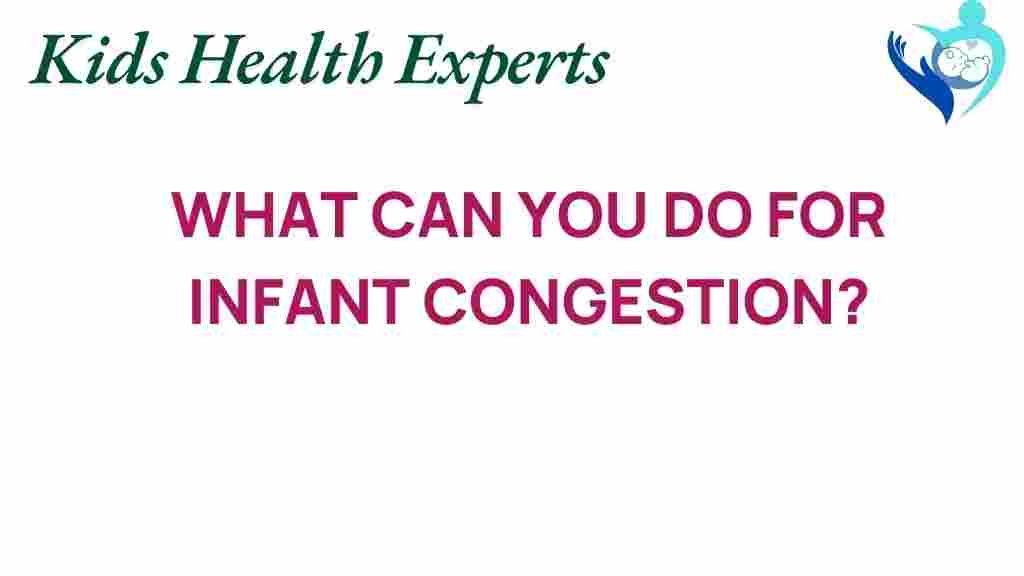Unveiling Solutions: What Can You Do for Infant Congestion?
As a parent, nothing is more concerning than seeing your little one struggle with health issues. One common issue that many parents face is infant congestion. This condition can lead to discomfort and can affect your baby’s overall wellness. Understanding how to handle respiratory issues in infants is crucial for ensuring their health and comfort. In this article, we will explore various soothing techniques, parental care tips, and expert pediatric advice on providing nasal relief and enhancing infant wellness.
Understanding Infant Congestion
Infant congestion occurs when the nasal passages of a baby become blocked or narrowed, often due to mucus buildup. This can lead to difficulty in breathing, feeding, and sleeping. Recognizing the signs of congestion is the first step in addressing this common issue.
Signs of Infant Congestion
- Stuffy or runny nose: Excess mucus can lead to a blocked nasal passage, making it hard for your baby to breathe comfortably.
- Wheezing or coughing: These sounds may indicate that your infant is struggling to breathe through their congested nose.
- Difficulty feeding: Congestion can make it hard for babies to suck effectively, leading to fussiness during feedings.
- Restlessness during sleep: Congestion may cause your baby to wake frequently or have trouble settling down to sleep.
Step-by-Step Solutions for Infant Congestion
When faced with infant congestion, there are several effective strategies you can implement to help soothe your baby and promote better breathing. Below are some parental care techniques that can be helpful:
1. Use a Humidifier
A cool-mist humidifier can add moisture to the air, helping to loosen mucus and relieve nasal congestion. Here’s how to use it effectively:
- Place the humidifier in your baby’s room while they sleep.
- Ensure it’s clean and filled with distilled water to prevent the growth of mold and bacteria.
- Maintain humidity levels between 30-50% for optimal results.
2. Nasal Saline Drops
Using saline drops can provide effective nasal relief for your infant. Here’s how to apply them:
- Lay your baby on their back.
- Administer 1-2 drops of saline solution in each nostril.
- Wait a few minutes and then use a bulb syringe to gently suction out the loosened mucus.
3. Elevate Their Head
Elevating your baby’s head while they sleep can help reduce congestion. Follow these steps:
- Place a rolled towel or a small pillow under the mattress to create a slight incline.
- Make sure your baby is still safe and secure in the crib.
4. Warm Baths
Giving your baby a warm bath can help ease congestion. The steam from the warm water can help open nasal passages. Here’s how to do it:
- Fill the tub with warm water (not hot) and let your baby sit in the bathroom with the door closed for about 15-20 minutes.
- This can also be a soothing time for bonding with your baby.
5. Gentle Chest Rubs
Using a gentle baby-safe chest rub can also provide comfort. Look for products specifically designed for infants. Here’s how to apply it:
- Use a small amount and gently massage it onto your baby’s chest and back.
- Ensure it is safe and suitable for their age, and follow the instructions on the label.
6. Keep Them Hydrated
Ensuring your baby stays hydrated is vital for their overall health and can help thin mucus. Offer breast milk or formula frequently. If your baby is older than six months, you can also introduce small amounts of water.
Pediatric Advice for Managing Infant Congestion
Always consult your pediatrician if your baby shows signs of severe congestion or if their overall condition worsens. Here are some general pediatric advice tips:
- Monitor symptoms: Keep a close eye on your baby’s symptoms and note any changes.
- Watch for fever: A fever in conjunction with congestion may indicate an infection that requires medical attention.
- Avoid over-the-counter medications: Many cough and cold medications are not recommended for infants. Always check with your pediatrician first.
When to Seek Medical Attention
While most cases of infant congestion can be managed at home, there are times when you should seek medical help:
- If your baby is having difficulty breathing or seems to be in distress.
- If symptoms last more than a week or worsen over time.
- If you notice any signs of dehydration, such as fewer wet diapers or a dry mouth.
- If your baby has a high fever (over 100.4°F) or shows signs of lethargy.
Troubleshooting Tips for Parents
Here are some troubleshooting tips if your baby’s congestion doesn’t seem to improve:
- Re-evaluate the humidifier: Ensure it’s working properly and the water is clean.
- Check the nasal saline dosage: Sometimes, using more saline drops can help if mucus remains thick.
- Adjust your baby’s positioning: Experiment with different positions during sleep to see if it alleviates congestion.
- Consider allergies: If congestion persists, consult with your pediatrician about possible allergies.
Conclusion: Prioritize Your Infant’s Wellness
Managing infant congestion requires patience and attentiveness. With the right parental care, soothing techniques, and pediatric advice, you can help your baby breathe easier and promote their overall health. Remember that while many cases of congestion can be treated at home, it’s essential to stay vigilant and consult your pediatrician when necessary. For more information on baby health and wellness, consider visiting healthychildren.org for expert resources.
By prioritizing your child’s wellness and utilizing these techniques, you can create a more soothing environment for your baby, thus enhancing their quality of life and ensuring peace of mind for you as a parent.
This article is in the category Care and created by KidsHealthExperts Team
